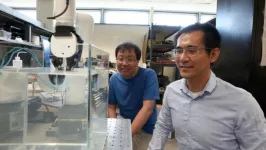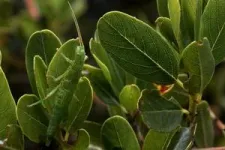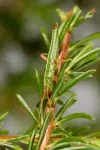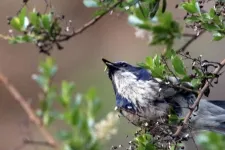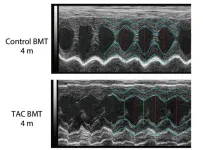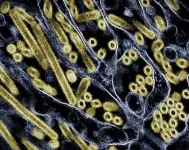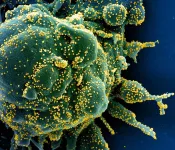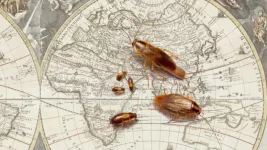(Press-News.org) Undergoing surgery is seldom a pleasant experience, and it can sometimes be highly invasive. Surgical procedures have evolved steadily over the centuries, growing with the knowledge of anatomy and biology.
Innovative methods have also been bolstered with new tools, and a growth in the use of robotics since the 1980s has moved health care forward significantly. Assistant Professor Zhenhua Tian has pressed forward another step in the march of progress using robotics and noninvasive acoustics, and his team’s work has been published in Science Advances.
Robot-assisted surgery
Surgery using robots has been invasive since its invention because cutting is involved and often other instruments are inserted into the incision. However, because robotic-assisted tools can be smaller, the cuts also tend to be smaller than traditional surgeries, making robotics a preferred choice. This form of surgery has proven its benefits and has grown in use over time, with advantages to patients including
Less discomfort and bleeding
Less time in the hospital
Faster recovery periods
In fact, according to the American College of Surgeons, 1.8 percent of surgeries included a robot in 2012. By 2018, that percentage had risen to 15.1 percent and continues to rise through advancements in robotics. Some of the most common procedures involving robotics include appendectomies, hysterectomies, and gastric bypasses.
Noninvasive sound treatment
While robotic-assisted surgery has its share of advantages, Tian's team has taken that idea a step beyond its current state: Team members are developing a method of moving small targets, such as cells and medicine, within a body that is noninvasive. That means the method requires no cuts.
The secret is found in acoustic energy emitters that Tian’s team uses to surround and capture particles, working like invisible tweezers. The emitters create 3D acoustic vortex fields that can pass through barriers such as bone and tissue, crossing over one another to form tiny ring-shaped acoustic traps. Micro- to millimeter-sized objects caught at the center of an acoustic trap can be moved and rotated. Tian received a 2024 National Science Foundation Faculty Early Career Development Program (CAREER) award for the acoustic vortex development.
“The ability to move cells and drugs around inside veins without breaking the skin creates new opportunities in medicine,” said Tian. “As we continue the work on this research, I anticipate we will find a host of new applications.”
By mounting an acoustic vortex emitter onto a robotic platform, the acoustic vortex beam can be moved at the micrometer scale. Accordingly, the particle trapping area can be precisely set in a 3D space, and moving a particle after its capture can be engineered. When moving a tiny object along the winding path of a blood vessel, this can be a critical feature.
More than medicine
While Tian’s team is able to move a small object behind a solid structure, the acoustic vortex beams can move particles within both gases and liquids as well. Although the current approach targets small particles within those substances, integrating the acoustic energy emitters together with robotics has applications beyond surgery and very small particles. Contactless, robotic manipulation has potential in many other applications across engineering, biology, and chemistry research. Some of those include
Controlling microrobots
Handling delicate bioparticles, such as exosomes and cells
Transporting hazardous reagent droplets
Controlling self-assembly of colloidal materials
Arranging nanomaterials for composite fabrication
“When we were recently participating in a STEM expo, the children who visited us enjoyed putting small beads into the invisible acoustic fields generated by our devices, but we would like to offer the opportunity for them to move larger objects,” said Tian. “Next year, we hope to have a larger emitter that can hold a ping pong ball. It will be interesting to see how we plug that approach into our other research.”
Related content
Zhenhua Tian receives National Science Foundation CAREER award to develop invisible acoustic tweezers
END
Virginia Tech researcher creates new tool to move tiny bioparticles
The "invisible tweezers" use robotics and acoustic energy to achieve what human hands cannot
2024-05-24
ELSE PRESS RELEASES FROM THIS DATE:
On repeat: Biologists observe recurring evolutionary changes, over time, in stick insects
2024-05-24
LOGAN, UTAH, USA – A long-standing debate among evolutionary scientists goes something like this: Does evolution happen in a predictable pattern or does it depend on chance events and contingency? That is, if you could turn back the clock, as celebrated scientist Stephen Jay Gould (1941-2002) described in his famous metaphor, “Replaying the Tape of Life,” would life on Earth evolve, once again, as something similar to what we know now, or would it look very, very different?
“If you frame it as an either/or question, it’s too simplistic,” says Utah State University evolutionary biologist Zachariah Gompert. “The answer isn’t ‘completely ...
Understanding a broken heart
2024-05-24
The stress of heart failure is remembered by the body and appears to lead to recurrent failure, along with other related health issues, according to new research. Researchers have found that heart failure leaves a “stress memory” in the form of changes to the DNA modification of hematopoietic stem cells, which are involved in the production of blood and immune cells called macrophages. These immune cells play an important role in protecting heart health. However, a key signaling pathway (a chain of molecules which ...
Genetic cause of rare childhood immune disorders discovered
2024-05-24
Scientists have pinpointed genetic changes that can leave children born with little to no immune defence against infection.
In a new study of 11 affected individuals, researchers from Newcastle University, the Wellcome Sanger Institute, the Great North Children’s Hospital, and their collaborators were able to link mutations in the NUDCD3 gene to Severe Combined Immunodeficiency and Omenn syndrome1 – rare and life-threatening immunodeficiency disorders. These mutations prevented the normal development of diverse immune cells needed to combat different pathogens2.
The findings, published today (24 May) in Science Immunology, ...
With wobbling stars, astronomers gauge mass of 126 exoplanets and find 15 new ones
2024-05-24
LAWRENCE — Using data from the Transiting Exoplanet Survey Satellite and W.M. Keck Observatory on Mauna Kea in Hawaii, an astronomer at the University of Kansas led a study appearing today revealing 15 new exoplanets — planets beyond our solar system — along with the mass of 126 other exoplanets. The findings give astronomers new understanding of the makeup of exoplanets and their star systems generally.
The study cataloging the exoplanets — comprising severe and exceptional environments, some of which hold promise to support life — was conducted under auspices of the TESS-Keck Survey and appears ...
High H5N1 influenza levels found in mice given raw milk from infected dairy cows
2024-05-24
WHAT:
Mice administered raw milk samples from dairy cows infected with H5N1 influenza experienced high virus levels in their respiratory organs and lower virus levels in other vital organs, according to findings published in the New England Journal of Medicine. The results suggest that consumption of raw milk by animals poses a risk for H5N1 infection and raises questions about its potential risk in humans.
Since 2003, H5N1 influenza viruses have circulated in 23 countries, primarily affecting wild birds and poultry with about 900 human cases, primarily among people who have had close contact with infected birds. In ...
Study finds discreet shipping used to sell e-cigarettes to minors
2024-05-24
Researchers at the U of A found self-identified small business owners on TikTok are circumventing a number of local, state and federal laws that restrict the individual sale of tobacco products. Specifically, the researchers found that 45% of the videos highlighted the fact that they did not require identification to verify the purchaser’s age.
“Many states have laws that govern procedures necessary to sell e-cigarettes,” explained lead researcher Page Dobbs, an associate professor of public health in the Department of Health, Human Performance and Recreation ...
African scientists call for equitable research partnerships to advance microbiome research
2024-05-24
Leading African scientists have issued a compelling call for more equitable research partnerships in a new paper published in Nature Medicine. The paper underscores the critical need for fair and collaborative research efforts to explore the unique and diverse microbiomes found in African populations and environments. Historically, these microbiomes have been underrepresented in global studies.
Over the past two decades, our understanding of the role played by the microbiome in different ecosystems has significantly expanded. For ...
How COVID-19 'breakthrough' infections alter your immune cells
2024-05-24
LA JOLLA, CA—New research from scientists at La Jolla Institute for Immunology (LJI) suggests people who received COVID-19 vaccines and then experienced "breakthrough" infections are especially well armed against future SARS-CoV-2 infections.
By analyzing blood samples from study volunteers, the LJI researchers discovered that people who experienced symptomatic breakthrough infections develop T cells that are better at recognizing and targeting SARS-CoV-2, including the Omicron and Delta variants. The researchers describe this increased protection as an "immunity wall."
"The virus evolves, but, importantly, so does the immune system. T cells ...
Virginia Tech entomologist sheds light on 250-year-old mystery of the German cockroach
2024-05-24
May 24, 2024 --
A team of international scientists, including Virginia Tech entomologist Warren Booth, have solved the 250-year-old origin puzzle of the most prevalent indoor urban pest insect on the planet: the German cockroach.
The team's research findings, representing the genomic analyses of over 280 specimens from 17 countries and six continents, show that this species evolved some 2,100 years ago from an outside species in Asia and were released this week in the Proceedings of the National Academy of Sciences journal.
One ...
Advancing skin science: explore Skin Ageing & Challenges 2024 Strategic Topics in Malta this November
2024-05-24
Get introduced to the latest advances in skin research at the 15th International Conference on Skin Ageing & Challenges 2024 on November 5-6 at Corinthia Palace in Malta.
Skin Ageing & Challenges 2024 will cover the hottest topics shaping the future of skin aging and rejuvenation.
How will Skin Ageing & Challenges 2024 Expand Your Knowledge?
Senolytics: Exploring new ways to fight cell aging with innovative senolytic treatments.
Extracellular Vesicles: Discovering the potential of EVs for skin regeneration and repair.
Skin Microbiota / Mitochondria Transplantation: Introducing approaches to harness the power of microbiome and mitochondrial transplantation ...
LAST 30 PRESS RELEASES:
Science briefing: An update on GLP-1 drugs for obesity
Lower doses of immunotherapy for skin cancer give better results
Why didn’t the senior citizen cross the road? Slower crossings may help people with reduced mobility
ASH 2025: Study suggests that a virtual program focusing on diet and exercise can help reduce side effects of lymphoma treatment
A sound defense: Noisy pupae puff away potential predators
Azacitidine–venetoclax combination outperforms standard care in acute myeloid leukemia patients eligible for intensive chemotherapy
Adding epcoritamab to standard second-line therapy improves follicular lymphoma outcomes
New findings support a chemo-free approach for treating Ph+ ALL
Non-covalent btki pirtobrutinib shows promise as frontline therapy for CLL/SLL
University of Cincinnati experts present research at annual hematology event
ASH 2025: Antibody therapy eradicates traces of multiple myeloma in preliminary trial
ASH 2025: AI uncovers how DNA architecture failures trigger blood cancer
ASH 2025: New study shows that patients can safely receive stem cell transplants from mismatched, unrelated donors
Protective regimen allows successful stem cell transplant even without close genetic match between donor and recipient
Continuous and fixed-duration treatments result in similar outcomes for CLL
Measurable residual disease shows strong potential as an early indicator of survival in patients with acute myeloid leukemia
Chemotherapy and radiation are comparable as pre-transplant conditioning for patients with b-acute lymphoblastic leukemia who have no measurable residual disease
Roughly one-third of families with children being treated for leukemia struggle to pay living expenses
Quality improvement project results in increased screening and treatment for iron deficiency in pregnancy
IV iron improves survival, increases hemoglobin in hospitalized patients with iron-deficiency anemia and an acute infection
Black patients with acute myeloid leukemia are younger at diagnosis and experience poorer survival outcomes than White patients
Emergency departments fall short on delivering timely treatment for sickle cell pain
Study shows no clear evidence of harm from hydroxyurea use during pregnancy
Long-term outlook is positive for most after hematopoietic cell transplant for sickle cell disease
Study offers real-world data on commercial implementation of gene therapies for sickle cell disease and beta thalassemia
Early results suggest exa-cel gene therapy works well in children
NTIDE: Disability employment holds steady after data hiatus
Social lives of viruses affect antiviral resistance
Dose of psilocybin, dash of rabies point to treatment for depression
Helping health care providers navigate social, political, and legal barriers to patient care
[Press-News.org] Virginia Tech researcher creates new tool to move tiny bioparticlesThe "invisible tweezers" use robotics and acoustic energy to achieve what human hands cannot
